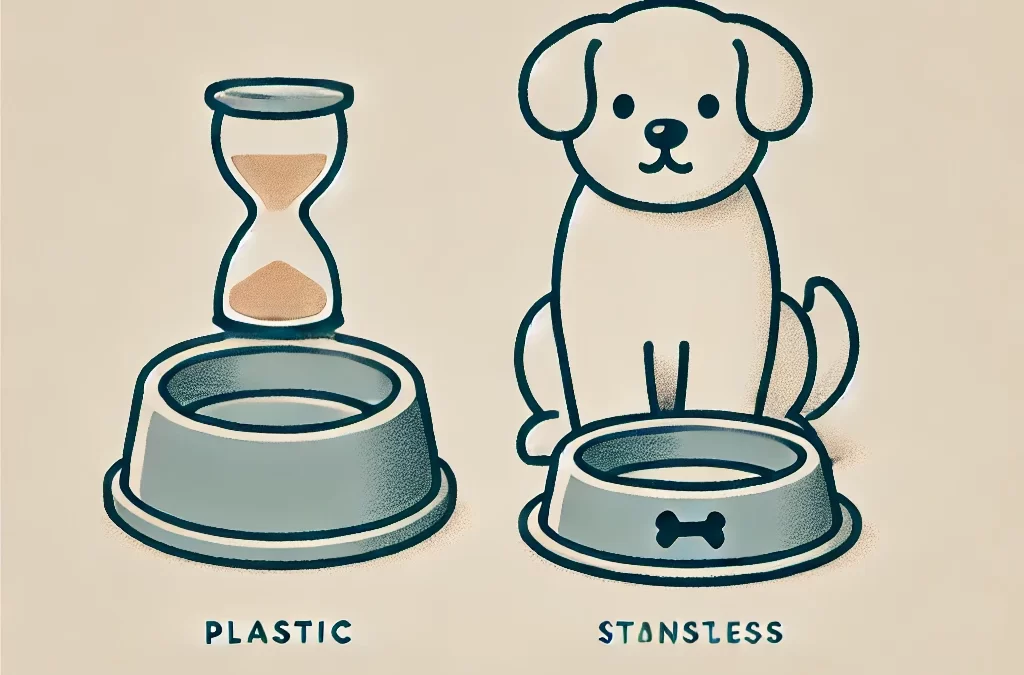
經過 TCMVET | 2024 年 12 月 12 日 | 狗癌症和腫瘤
狗的腎癌相對罕見,但發生時會嚴重影響狗的健康。這些症狀通常是逐漸出現的,因此早期發現具有挑戰性。了解潛在跡象可以幫助寵物主人及時尋求獸醫護理。
狗腎癌的常見症狀
- 口渴和排尿增多(煩渴和多尿):
- Loss of Appetite:
- Weight Loss:
- 即使食物攝取量正常,當身體消耗能量對抗疾病時,體重也會減輕。
- 嘔吐和噁心:
- 癌症引起的腎功能障礙會導致血液中毒素積聚,造成胃腸道問題。
- 腹部疼痛或腫脹:
- 尿中帶血(血尿):
- Lethargy:
- 患有腎癌的狗可能會表現出能量水平降低並且不願意進行正常活動。
- Difficulty Breathing:
- 在晚期病例中,腫瘤可能會壓迫周圍器官,導致呼吸問題。
- 牙齦蒼白:
- 口臭(尿毒症口氣):
- 由於腎功能下降而導致血液中毒素積聚,產生類似氨的氣味。
何時去看獸醫
如果您的狗表現出這些症狀的任何組合,則必須立即尋求獸醫的注意。雖然這些跡象並非腎癌所獨有,但它們通常表明存在嚴重的潛在健康問題,需要診斷和治療。
犬腎癌的診斷
獸醫通常會使用以下方法來確認腎癌:
- 體檢: 檢測腫脹或不適。
- 尿液分析: 檢查血液或尿液中是否有異常物質。
- 血液檢查: 評估腎功能並檢測任何異常。
- 成像: 超音波、X 光或 CT 掃描可以識別腫瘤及其範圍。
- 切片檢查: 可以採集腫瘤樣本來確認其性質。
治療和預後
治療方案取決於腫瘤類型和階段,但可能包括:
- 手術: 如果癌症是局限性的,則切除受影響的腎臟(腎切除術)。
- 化療: 對於某些類型的癌症,化療可能會減緩進展。
- 支持護理: 疼痛管理、補水和營養支持,以維持生活品質。
早期發現可以改善治療效果,因此定期獸醫檢查至關重要,尤其是對於老年犬。
透過識別這些症狀並迅速採取行動,您可以為您的狗提供有效護理並保持良好生活品質的最佳機會。

經過 TCMVET | 2024 年 12 月 11 日 | 狗癌症和腫瘤
塑膠在我們的日常生活中無處不在,從食品容器到家居用品,甚至在為我們毛茸茸的朋友設計的產品中。但這種看似無害的材料會對我們的狗的健康構成威脅嗎?最新研究表明,長期接觸某些類型的塑膠可能會增加狗患癌症的風險。讓我們探索科學以及寵物主人可以採取哪些措施來保護他們的寵物。
塑膠的隱患
許多類型的塑膠都含有有害化學物質,例如雙酚 A (BPA)、鄰苯二甲酸鹽和聚氯乙烯 (PVC)。這些化學品通常用於製造耐用、柔韌或透明的塑膠。然而,它們可能會滲入食物、水甚至環境中,特別是當塑膠被加熱、刮傷或降解時。
在動物中,這些化學物質可以作為內分泌幹擾物,幹擾荷爾蒙功能。長時間接觸可能會導致細胞變化、氧化壓力,甚至腫瘤形成,增加癌症的可能性。對於狗來說,其日常習慣通常包括咀嚼、舔舐以及與各種材料的密切接觸,因此風險更加複雜。
狗狗日常接觸塑膠的來源
- 食物和水碗:許多狗主人在不知情的情況下使用塑膠碗,塑膠碗會釋放有害物質,尤其是在刮傷或暴露在陽光下時。
- 咀嚼玩具:低品質的塑膠玩具通常含有不受管制的材料,大量攝入或咀嚼可能會造成風險。
- 包裝:狗糧、粗磨食品和其他產品通常儲存在塑膠包裝中,這可能會將化學物質滲入食物中。
- 家居用品:狗經常接觸房子周圍的塑膠物品,從容器到家具。
與塑膠相關的癌症風險
雖然塑膠接觸與狗癌症之間的直接聯繫仍在研究中,但人類和動物研究的證據表明存在令人擔憂的關係。對於狗來說,乳腺癌、睪丸癌和淋巴瘤等癌症可能會受到環境毒素(包括塑膠中的毒素)的影響。較小的品種或已有健康狀況的狗可能特別容易受到傷害。
減少塑膠接觸的步驟
寵物主人可以採取積極措施,盡量減少狗狗接觸有害塑膠:
- 改用更安全的碗:使用不鏽鋼、陶瓷或玻璃碗盛裝食物和水,而不是塑膠碗。
- 選擇高品質的玩具:選擇無毒、不含 BPA 的玩具或由橡膠等天然材料製成的玩具。
- 重新思考儲存:將狗糧和零食存放在玻璃或不銹鋼製成的密封容器中,而不是放在原來的塑膠包裝中。
- 檢查您的家:限制您的狗接觸可能被咀嚼或攝入的低品質塑膠物品。
- 避免加熱塑料:切勿用微波爐加熱塑膠容器中的食物或零食,因為熱會增加化學浸出。
倡導更安全的標準
除了個人選擇之外,寵物主人還可以倡導寵物產品產業提高安全標準。支持優先考慮無毒材料和永續實踐的品牌發出了強有力的信息。此外,隨時了解產品召回或新興研究可以幫助保護您的狗免受隱藏風險。
更大的圖景
雖然塑膠在現代生活中無所不在,但其潛在的健康影響也不容忽視。對於我們的狗來說,減少接觸有害塑膠是支持其長期健康和福祉的簡單而有效的方法。透過做出有意識的選擇和傳播意識,我們可以確保我們的寵物過著更快樂、更健康的生活。

經過 TCMVET | 2024 年 12 月 11 日 | 狗癌症和腫瘤
對狗來說,體型確實很重要,但不僅僅是我們通常認為的那樣。雖然大型犬因其力量而受到讚賞,而小型犬因其魅力而受到讚賞,但最近的研究發現,狗的體型與患癌症的風險之間存在令人驚訝的關聯。讓我們深入研究這個有趣的鏈接,並探討它對寵物主人意味著什麼。
體型和癌症風險背後的科學
研究表明,較大的品種,如大丹犬、伯恩山犬和羅威納犬,與較小的同類相比,更容易患某些癌症。但為什麼?答案在於生物學。大型犬生長得更快,體內的細胞也更多。這種細胞活動的增加增加了突變的機會,從而導致癌症。
另一方面,像吉娃娃和臘腸犬這樣的小型品種往往具有較低的癌症風險,但並非完全免疫。某些癌症,例如肥大細胞瘤,仍然會影響較小的狗,通常是由於遺傳傾向而不是體型大小。
快速成長:一把雙面刃
大型犬種在幼犬時期經歷快速生長,給它們的身體帶來巨大的壓力。這種快速生長會導致細胞分裂不穩定,從而隨著時間的推移增加細胞行為異常的風險。此外,大型犬的新陳代謝需求可能會加速衰老,使它們隨著年齡的增長更容易患上疾病,包括癌症。
長壽和癌症風險
小型犬通常比大型犬壽命長得多。雖然這種長壽使小型犬有更多的時間發展與年齡相關的疾病,但這也意味著它們較慢的生長和細胞更新可能會保護它們免受大型犬種常見的早發性癌症的影響。相較之下,大型犬的壽命較短,通常與年輕時侵襲性癌症的盛行率較高有關。
寵物主人可以做什麼
無論狗的體型大小,寵物主人都可以採取積極措施來最大程度地降低癌症風險。定期的獸醫檢查、均衡的飲食和適當的運動是必不可少的。對於大型品種,應特別注意保持健康的體重,因為肥胖會進一步加劇癌症風險。小型犬雖然不太容易罹患與體型相關的癌症,但仍受益於基因篩檢以儘早發現遺傳風險。
重新定義“尺寸很重要”
體型與癌症風險之間的關聯促使我們重新思考我們的狗護理方法。雖然我們無法改變狗的體型,但了解它如何影響它們的健康可以幫助我們做出明智的決定。從選擇品種到客製化護理程序,這些知識使寵物主人能夠為他們的毛茸茸的朋友提供長壽、健康生活的最佳機會。
最後,無論大小,每隻狗都值得愛、關注和積極的醫療保健。透過隨時了解情況,我們都可以在降低癌症風險和確保我們的犬類伴侶茁壯成長方面發揮作用。

經過 TCMVET | 2024 年 12 月 9 日 | 狗癌症和腫瘤
狗的脊椎腫瘤雖然罕見,但會嚴重影響它們的活動能力和生活品質。這些腫瘤可能在脊椎內或周圍生長,影響神經系統的功能。早期發現和適當的管理對於為您毛茸茸的朋友提供最好的護理至關重要。這是關於狗脊椎腫瘤類型及其症狀、原因和治療選擇的綜合指南。
狗的常見脊椎腫瘤類型
- 髓內腫瘤
- 描述: 這些腫瘤起源於脊髓本身。它們通常來自支持神經系統的神經膠質細胞。
- 範例: 星狀細胞瘤、室管膜瘤和少突膠質細胞瘤
- 症狀: 逐漸無力、不協調,嚴重時可能癱瘓
- 治療: 手術(如果可能)、放射治療和支持性治療
- 硬膜外腫瘤
- 描述: 這些腫瘤發生在脊髓外但在椎管內,通常會壓迫脊髓並引起神經系統問題。
- 範例: 骨肉瘤、纖維肉瘤和淋巴瘤
- 症狀: 背痛、行走困難和肌肉無力
- 治療: 手術切除、化療或放療,取決於腫瘤類型
- 硬腦膜內髓外腫瘤
- 描述: 這些腫瘤位於椎管內但在脊髓外,在周圍的腦膜或神經根中生長。
- 範例: 腦膜瘤、神經鞘瘤(神經鞘瘤)
- 症狀: 疼痛、不協調,並可能出現尿失禁或腸失禁
- 治療: 手術和放射治療
- 椎骨腫瘤
- 描述: 這些腫瘤起源於脊椎骨骼,導致結構不穩定和脊髓潛在受壓。
- 範例: 骨肉瘤、軟骨肉瘤
- 症狀: 嚴重疼痛、腫脹以及站立或行走困難
- 治療: 手術、化療和疼痛管理
Symptoms of Spinal Tumors in Dogs
脊椎腫瘤的症狀可能因腫瘤的位置和大小而異,但常見的徵兆包括:
- 不願移動或玩耍
- 行走困難或拖拉四肢
- 背部或頸部疼痛或敏感
- 膀胱或腸道失控
- 行為或姿勢突然改變
原因和風險因素
狗的脊椎腫瘤可能由以下原因引起:
- 遺傳易感性: 德國牧羊犬和黃金獵犬等某些品種可能面臨更高的風險。
- Age: 年長的狗狗更容易罹患脊椎腫瘤。
- 癌症轉移: 身體其他部位的腫瘤可能會擴散到脊椎。
診斷和治療
獸醫使用多種方法來診斷脊椎腫瘤:
- 神經學檢查: 評估反射、協調性和疼痛反應。
- 成像: X 光、MRI 或 CT 掃描來定位和評估腫瘤。
- 切片檢查: 確認腫瘤類型以進行標靶治療。
治療方案包括:
- 手術: 對於可觸及和可手術腫瘤的首選方法。
- 放射治療: 用於無法手術或術後殘留的腫瘤。
- 化療: 對某些轉移性或原發性脊椎腫瘤有效。
- 疼痛管理: 對於改善狗的生活品質至關重要。
支持您的狗康復
患有脊椎腫瘤的狗的護理應包括:
- 提供柔軟、有支撐作用的床以預防壓瘡
- 透過安全帶或手推車協助移動
- 維持營養飲食以支持整體健康
- 定期與獸醫追蹤以監測進展
結論
狗的脊椎腫瘤需要及時關注和專門護理。雖然預後取決於腫瘤類型和進展,但獸醫學的進步使治療更有效。透過了解症狀和可用的選擇,您可以確保您的狗得到最好的照顧和支持。

經過 TCMVET | 2024 年 12 月 9 日 | 狗癌症和腫瘤
狗狗的皮膚健康通常是其整體健康狀況的一面鏡子,但有些情況即使是最細心的寵物主人也會感到困惑。其中一種罕見的情況是 角化上皮瘤一種良性皮膚腫瘤,因其外觀和影響而引起關注。讓我們深入研究這種不尋常的皮膚病、其原因、治療方法,以及是什麼使它成為犬類醫療保健的獨特挑戰。
什麼是角化上皮瘤?
角化上皮瘤是起源於皮脂腺的良性腫瘤,特別是負責角質蛋白產生的上皮(皮膚細胞)。這些腫瘤通常在狗的皮膚上表現為結節狀、疣狀生長。雖然它們不會危及生命,但它們可能引起不適或感染,因此不應忽視它們。
角化上皮瘤的病因是什麼?
角化上皮瘤的確切原因尚不完全清楚,但影響因素可能包括:
- 遺傳易感性: 可卡犬、比格犬和西伯利亞哈士奇等品種更容易出現這些生長。
- 荷爾蒙失衡: 皮脂腺活動可能會受到荷爾蒙變化的影響,尤其是老年犬。
- 飲食缺陷: 營養不良會導致皮膚健康失衡,可能加劇上皮瘤等疾病。
認識症狀
角化上皮瘤通常表現為:
- 小而堅硬的結節,具有疣狀紋理
- 由於角蛋白堆積,顏色呈現淡黃色或蠟狀
- 局限於頭部、頸部或背部,但也可能發生在任何地方
- 如果繼發性感染,偶爾會伴隨紅腫或炎症
雖然這些生長是良性的,但尺寸、顏色或質地的快速變化應由獸醫進行評估,以排除惡性腫瘤。
診斷角化上皮瘤
診斷通常涉及:
- 體檢: 獸醫將評估增生的大小、位置和外觀。
- 細針穿刺切片檢查 (FNA): 提取並分析細胞樣本以確認腫瘤的性質。
- 切片檢查: 在某些情況下,可能需要進行活檢來區分良性上皮瘤和其他皮膚病或癌症。
治療方案
治療取決於上皮瘤的嚴重程度以及對狗生活品質的影響。
- 監控
對於小型、無問題的生長,定期監測通常就足夠了。
- 確保該區域保持清潔且沒有感染。
- 如果獸醫建議,請使用舒緩的局部治療。
- 手術切除
如果生長物引起不適、反覆感染或美觀問題,手術切除是常見的解決方案。
- 局部或全身性治療
- 類維生素A或維生素A補充劑可以調節角蛋白的產生。
- 可以開抗生素治療繼發性細菌感染。
創新和自然的方法
對於希望透過整體護理補充傳統治療的業主:
- Omega-3 脂肪酸: 這些可以減少發炎並促進整體皮膚健康。
- 草藥療法: 金盞花和蘆薈可以舒緩受刺激的部位。
- 飲食調整: 富含抗氧化劑和優質蛋白質的飲食有助於皮膚再生。
預防措施
儘管並非所有角化上皮瘤病例都可以預防,但以下步驟可以幫助保持最佳的皮膚健康:
- 定期梳理: 保持皮膚清潔並促進及早發現異常。
- 均衡飲食: 支持免疫系統並減少皮膚問題的可能性。
- 常規獸醫就診: 早期介入是管理任何皮膚狀況的關鍵。
犬皮膚病學的獨特挑戰
角化上皮瘤凸顯了了解和解決狗狗罕見疾病的重要性。雖然這些生長是良性的,但會影響寵物的舒適度和外觀,因此及時有效的管理至關重要。透過隨時了解情況並與您的獸醫密切合作,您可以確保您的狗保持健康、快樂和茁壯成長。





